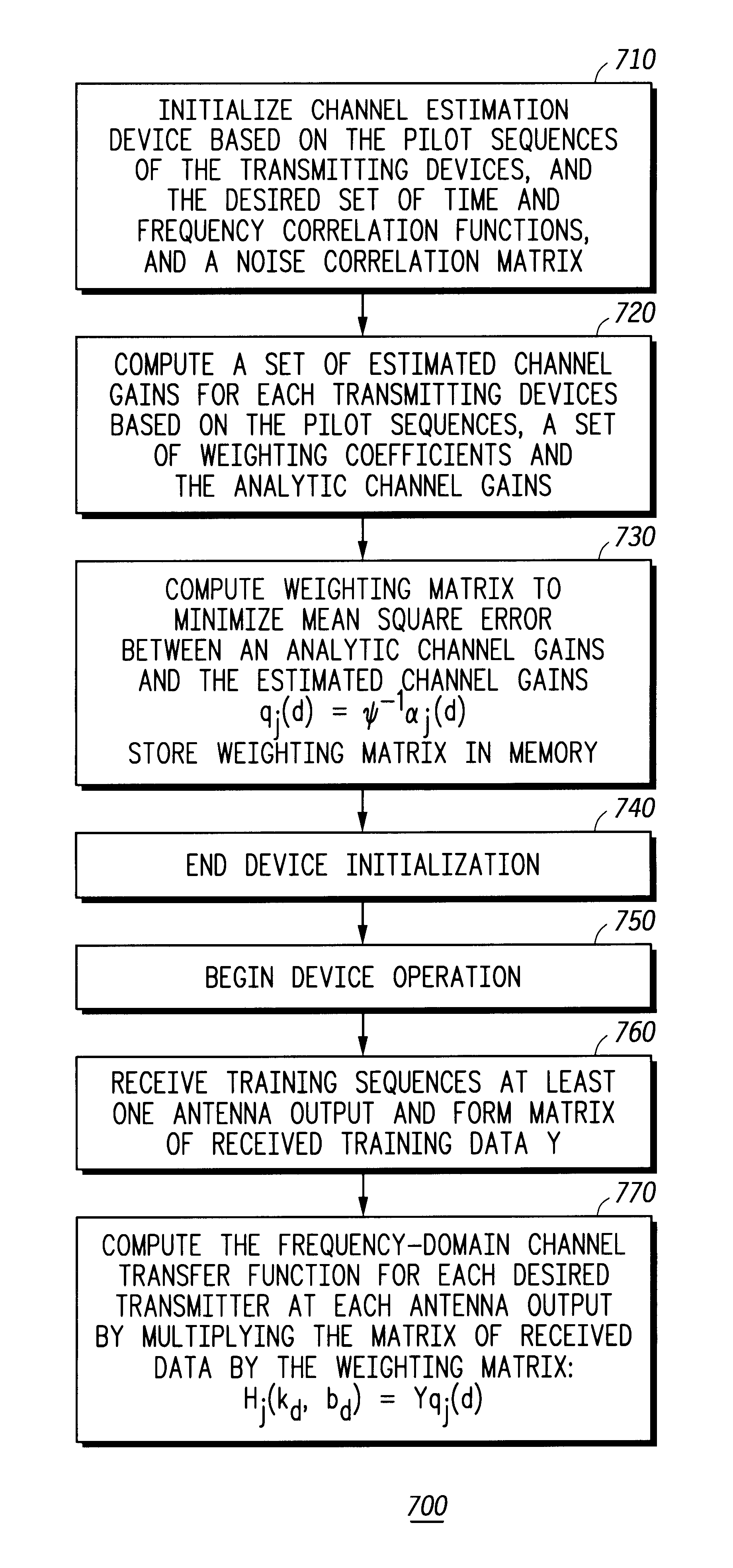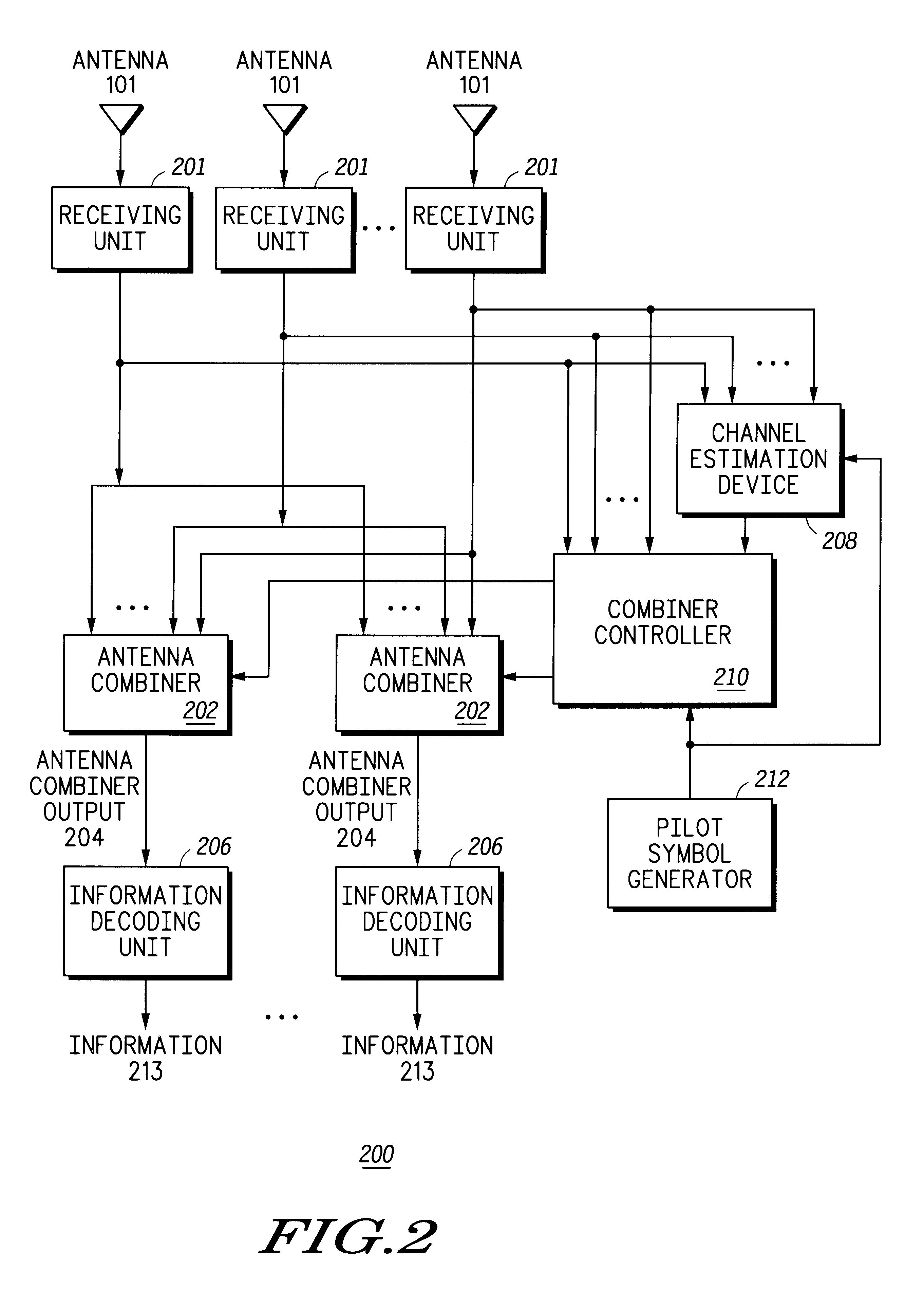Method and device for multi-user channel estimation
a multi-user channel and estimation method technology, applied in the field of wireless communication systems, can solve the problems of limiting the achievable performance and capacity of a communication system, severely distorting the received signal, and maximizing system capacity and performan
- Summary
- Abstract
- Description
- Claims
- Application Information
AI Technical Summary
Problems solved by technology
Method used
Image
Examples
first embodiment
For the reduced complexity channel estimator, we assume that the existing channel estimator for user j on subcarrier k at time block b can be expressed in the following form:
H.sub.j (k,b)=YE.sub.j (k,b) (37)
where H.sub.j (k,b) is a M.times.1 vector of the auxiliary frequency-domain channel gains for user j at subcarrier k and time block b, Y is the M.times.P matrix of received pilot data, and E.sub.j (k,b) is a primary weighting matrix of the existing channel estimator. The present invention finds a P.times.L matrix (referred to as the frequency to reduced time weighting coefficients), Q.sub.j (b), that is a function of the primary weighing coefficients, that when multiplied by the received pilot data will give a set of time-domain channel gains that completely parameterize the frequency-domain channel on time block b. The set of time-domain channel gains are then FFT'd (or similarly transformed) into the frequency-domain to get the set of frequency-domain channel estimates. Due to ...
second embodiment
the reduced complexity estimator works by parameterizing each tap corresponding to a single lag value n or subcarrier k=n (represented by the entries in h.sub.j (n,b)) by the IDFT of a small number of frequency-domain taps (referred to as Doppler taps). This is done akin to the above parameterization by parameterizing the time-varying h.sub.j,m (n,b) of user j on antenna m by V.sub.T =(2V+1) time-invariant "Doppler" channels, g.sub.j,m,v (n) (v=-V, . . . ,+V) as given in the following equation: ##EQU27##
where c(b) and g.sub.j,m (n) are V.sub.T.times.1 vectors defined as: ##EQU28##
We assume that the existing channel estimator can be expressed in the following form:
h.sub.j (b)=YQ.sub.j (b) (48)
where Y is a M.times.P matrix of received pilot data, Q.sub.j (b) is the existing channel estimator (in the preferred embodiment, this is the same Q.sub.j (b) as in Equation (44)), and:
h.sub.j (b)=[h.sub.j (0,b).vertline. . . . .vertline.h.sub.j (L-1,b)] (49)
The "Doppler" channels are found by s...
third embodiment
the reduced complexity estimator is a combination of the first and second ways. This is done by using the Q.sub.j (b) of Equation (44) in Equation (48). Here Z.sub.j,l is referred to as the reduced time to reduced frequency weighting coefficients. The computational complexity for the Doppler channel parameterization of the existing channel estimator in number of complex multiplies is (for the above example with V=1, V.sub.T =3): JV.sub.T M(PL+(N / 2)log .sub.2 (N))=5,706,288. This has 163.5 times less complex multiplies than the frequency-domain existing channel estimator and 2.67 times fewer complex multiplies than the time-domain only parameterization of the existing channel estimator with nearly identical performance.
FIG. 7 is a flow chart representation of the method performed by a preferred embodiment of the channel estimation device of 500 to compute the channel gain between at least one transmitting device and at least one receiving antenna in accordance with the present invent...
PUM
 Login to View More
Login to View More Abstract
Description
Claims
Application Information
 Login to View More
Login to View More - R&D
- Intellectual Property
- Life Sciences
- Materials
- Tech Scout
- Unparalleled Data Quality
- Higher Quality Content
- 60% Fewer Hallucinations
Browse by: Latest US Patents, China's latest patents, Technical Efficacy Thesaurus, Application Domain, Technology Topic, Popular Technical Reports.
© 2025 PatSnap. All rights reserved.Legal|Privacy policy|Modern Slavery Act Transparency Statement|Sitemap|About US| Contact US: help@patsnap.com



